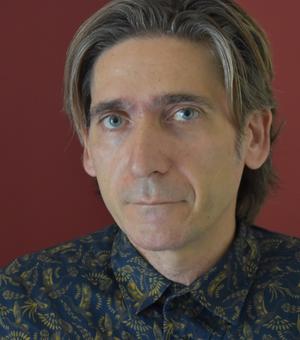Professor Lambros Malafouris
Research Interests
Archaeology of mind; Creativity, cognition and material culture; Anthropological archaeology; Anthropological and archaeological theory; Anthropology of making; Process archaeology; Human becoming; Material engagement theory; Material semiotics; Materiality and mental health.
Current Activities
My primary interest lies in the study of the interaction between cognition and material culture. I am studying the effects of materiality in human cognitive life (past and present). A major aspect of my work has been the development of Material Engagement Theory (MET) which forms the basis of my first authored book, How Things Shape the Mind (MIT Press) (https://mitpress.mit.edu/books/how-things-shape-mind). I have been addressing empirical and theoretical questions on topics extending from early stone tools and personal decoration, to the emergence of symbolic technologies of more recent periods, to the latest innovations in digital techniques and media.
My approach to research has been intra- and cross-disciplinary. I am using the insights that we gain from the archaeological and anthropological study of material culture to establish a critical dialogue with the broader field of cognitive sciences about the boundaries, the ontology, and the uniqueness of human intelligence and its evolution. I have been trying to understand and to articulate the basic principles of the creative entanglement between the plasticity of the human mind and the plasticity of the material forms and techniques that we make (metaplasticity).
I am currently Principal Investigator of HANDMADE: Understanding Creative Gesture in Pottery Making (https://handmade.web.ox.ac.uk/home) funded through a European Research Council (ERC) Consolidator Grant. The HANDMADE project is focusing on the cognitive ecology and poetics of clay. HANDMADE attempts a comparative anthropological exploration of the creative dialogue between hands and clay through multi-sited participant observation in several traditional ceramic workshops spread around mainland Greece and the Islands.
Links
- HANDMADE: Understanding Creative Gesture in Pottery Making
- SELFBOUND: The Making of Human Consciousness
- Material Engagement and Mental Health
- Hertford Page
Teaching
Undergraduate teaching
I am teaching undergraduate tutorials in Archaeology and Anthropology (both at prelims and finals) and I am co-Director of Studies for undergraduates at Hertford College.
Graduate teaching
I am teaching the module on cognitive archaeology on the MSc Archaeology course. I am also supervising research students in the general areas of Cognitive, Anthropological and Theoretical archaeology. I welcome enquiries from individuals wishing to undertake doctoral or post-doctoral research in those fields, especially from students with an interest in cognitive archaeology and material engagement theory.
I welcome enquiries and I am happy to supervise doctoral or post-doctoral research in the general areas of cognitive, anthropological and theoretical archaeology. Especially from students with an interest in material engagement theory, the relationship cognition and material culture, the anthropology of technics, creativity, making, self and the body, human becoming, material semiotics, and the effects of materiality on mental health.
Current students
| Cretan Hieroglyphic in process: Rethinking the ecology of writing in the Cretan Bronze Age Arthur Coppée | DPhil Archaeology | Supervisor: Lambros Malafouris |
| Digital Technology, Cultural Heritage, and the Creation of Landscapes of Power. Savannah Milton | DPhil Archaeology | Supervisors: Lambros Malafouris and John Pouncett |
| Weaving Material Mind Maps: Cognitive Networks Based on the Semiotic Variants of Dolmens on the Korean Peninsula Hoin Song | DPhil Archaeology | Supervisors: Lambros Malafouris and John Pouncett |
| Rethinking the Chaine Operatoir Approach: Agency, Cognition, and Temporality in Bronze Age Aegean Pottery Production Katie Slaughter | DPhil Archaeology | Supervisor: Lambros Malafouris |
| Potting in the Pandemic: Investigating pottery skill development and its affective impact in COVID-19 Britain Catherine O'Brien | DPhil Archaeology | Supervisor: Lambros Malafouris |
| Aesthetic Preference, Cognitive Ecologies, and Pleistocene Lithics: Towards an Enactive Evolutionary Aesthetics Jim Hicks | DPhil Archaeology | Supervisor: Lambros Malafouris |
| Style as Memory: A Cross-disciplinary Approach to the Knossian Kamares Style Emanuele Prezioso | DPhil Archaeology | Supervisor: Lambros Malafouris |
| The role of materiality in the formation of social memory: Studying the life histories of the Mycenaean Shaft Grave stelae Chaoying Wang | DPhil Archaeology | Supervisor: Lambros Malafouris |
| Clayful Phenomenology and Material Engagement: explorations in contemporary cognitive archaeology Paul March | DPhil Archaeology | Supervisor: Lambros Malafouris |
Past students
| In the Spirit of Engagement: Memories and the sensorium in Algonquin canoe building Jonathan Goldner-Jacobs (2022) ORA | DPhil Archaeology | Supervisor: Lambros Malafouris |
| Primate Archaeology: Comparative models for the evolution of primate technical cognition through tool use Hannah Mosley (2021) ORA | DPhil Archaeology | Supervisor: Lambros Malafouris |
| Communities of Practice Theory in Egyptian Archaeology: A Case Study for Its Application with Old Kingdom Sealings and Seal Impressions from Giza Siobhan Shinn (2021) ORA | DPhil Archaeology | Supervisors: Lambros Malafouris and Paul Collins |
| The Marble Kyklos: Social Cognition, Social Complexity and Material Engagement in the Aegean Bronze Age Alexander Aston (2020) ORA | DPhil Archaeology | Supervisor: Lambros Malafouris |
| Prehistoric Aesthetics: An Ontology of Stone Age Art from the Lower Palaeolithic until the Neolithic Brecht Govaerts (2020) ORA | DPhil Archaeology | Supervisors: Lambros Malafouris and Chris Gosden |
| Affect and materiality in therapeutic spaces. A contemporary archaeology of hospices John Harries (2020) ORA | DPhil Archaeology | Supervisor: Lambros Malafouris |
| Materiality in numerical cognition: Material Engagement Theory and the counting technologies of the Ancient Near East Karenleigh Overmann (2016) ORA | DPhil Archaeology | Supervisors: Lambros Malafouris and Chris Gosden |
| The Prehistory of Material Signification: Tracing the Nature and Emergence of Early Body Ornamentation through a Pragmatic and Enactive Theory of Cognitive Semiotics Antonios Iliopoulos (2015) ORA | DPhil Archaeology | Supervisors: Michael Petraglia and Lambros Malafouris |
Key words: materiality, wellbeing, cognitive archaeology, anthropological archaeology, archaeological theory, self and the body, creativity and human becoming




